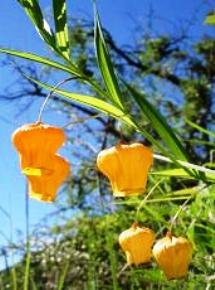Sandersonia aurantiaca

Author: Ivan Lätti
Photographer: Judd Kirkel Welwitch
Sandersonia aurantiaca, commonly known as Christmas bells or Chinese lantern lily and geelklokkie (little yellow bell) in Afrikaans, is a cormous perennial, a climbing or sprawling herb reaching heights from 75 cm to 1,5 m. The small corms are deep-seated, stolon-like and lobed, covered in thin tunics. The species is monotypic, i.e. the only one in its genus.
The species distribution is in the east of South Africa, from the north of the Eastern Cape and KwaZulu-Natal to southern Mpumalanga and eSwatini.
The habitat is moist grassland, the margins of bush clumps and forests, as well as succulent Karoo, often in full sun. The flowers are mostly seen after fires. The habitat population is deemed near threatened early in the twenty first century, due to habitat loss, invasive exotic vegetation, poor fire management and excessive flower picking.
The plant is used in traditional medicine. Although not much cultivated, it is used as a container plant and known horticulturally in New Zealand. The flowers last long, may still be popular as a cut flower. In olden times some indigenous populations used the rootstock as an aphrodisiac and plant parts as a charm for protection from evil (Manning, 2009; Leistner, (Ed.), 2000; Pooley, 1998; iNaturalist; https://pza.sanbi.org; http://redlist.sanbi.org).

